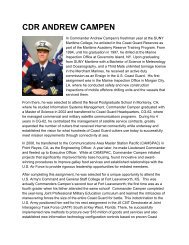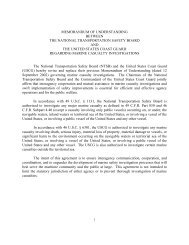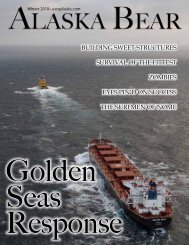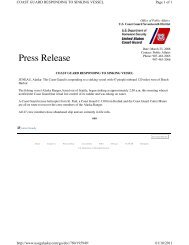marine board report - Off Soundings
marine board report - Off Soundings
marine board report - Off Soundings
You also want an ePaper? Increase the reach of your titles
YUMPU automatically turns print PDFs into web optimized ePapers that Google loves.
than its tonnage. The system also provides redundant means of distress alerting, and<br />
emergency sources of power.<br />
United States SafetyNET broadcasts include:<br />
• Navigational warning broadcasts from the U.S. National Imagery and Mapping Agency<br />
• Meteorological forecasts and warnings from the U.S. National Weather Service<br />
• Distress alerts and search and rescue warnings from the U.S. Coast Guard<br />
• Atlantic ice <strong>report</strong>s from the International Ice Patrol, U.S. Coast Guard<br />
b. SafetyNET Services. Virtually all navigable waters of the world are covered by INMARSAT<br />
satellites. Each satellite transmits Enhanced Group Call (EGC) traffic (including SafetyNET)<br />
on a designated channel at 1.5 GHz. Any ship sailing within the coverage area of an<br />
INMARSAT satellite will be able to receive all SafetyNET messages broadcast over this<br />
channel by that satellite. All INMARSAT-C maritime ship stations can monitor the EGC<br />
channel. The EGC channel can also be monitored by dedicated receive-only equipment<br />
installed separately or as part of an INMARSAT A station. (INMARSAT A is voice and data<br />
transmission system whereas INMARSAT C is a data transmissions system only.) USCG<br />
SafetyNET messages are broadcast via Telenor Satellite Services, Inc. (formerly COMSAT),<br />
a commercial satellite service provider.<br />
SafetyNET messages have five parameters: message priority, service code, address code,<br />
repetition code, and presentation code. The International SafetyNET Manual provides<br />
guidelines on the use of these parameters for SAR messages.<br />
The designation of priorities in the SafetyNET system determines the order in which a<br />
message is broadcast. INMARSAT-C is a store and forward system where messages of<br />
higher priority are placed at the head of the queue for broadcast. The two highest priorities,<br />
Distress and Urgent, also set off the alarms of certain ship<strong>board</strong> INMARSAT-C terminals,<br />
notifying the <strong>marine</strong>r that a high priority message had been received.<br />
The address code allows messages to be sent to a circular or rectangular area. The ship’s<br />
INMARSAT-C satellite terminal filters all the messages received from the satellite based on<br />
the ship’s position, entered manually or via navigational receiver. Messages are only<br />
displayed/printed if addressed to an area containing the vessel’s position. If the terminal is<br />
not connected to a navigational receiver, or the position is not updated, then it will<br />
display/print all messages broadcast over the satellite. Ships will receive all messages<br />
addressed to a NAVAREA if the user has entered the NAVAREA number into the terminal.<br />
c. USCG SafetyNET Broadcasts. U.S. Coast Guard Rescue Coordination Centers (RCCs)<br />
disseminate and monitor SAR distress related information using the INMARSAT SafetyNET<br />
system when the SAR case location is deemed to be outside the coverage of NAVTEX. In<br />
general, NAVTEX coverage extends to 200 NM off the coast. NAVTEX coverage in Alaska<br />
is limited by the length and characteristics of the coastline.<br />
29












